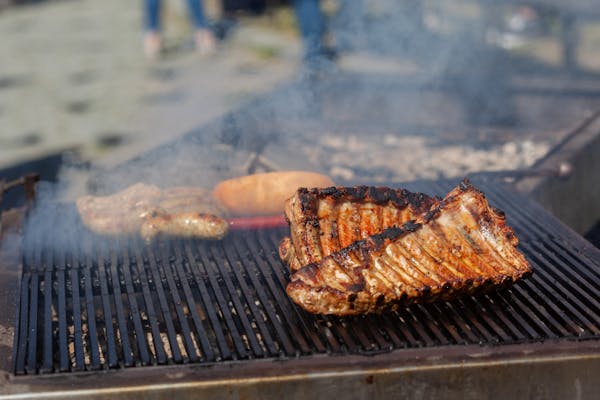Have you ever made a smoked dish that was too smoky? Finding the right balance between wood smoke and your ingredients is hard. But don’t worry; we have the tips you need to get it right. Are you ready to learn how to counteract smoky flavor in your dishes?
The Art of Smoking Meat
Smoking meat is a special process that combines smoke, heat, and time. These elements turn simple meat into a gourmet treat. It’s a craft that blends art and science, needing patience and knowledge of heat, smoke, and meat.
Choosing the Right Smoker
The type of smoker you use affects the taste and texture of smoked meats. You can choose from electric, offset, or charcoal smokers, each with its own benefits. Electric smokers are easy to use and keep a steady temperature. Offset smokers give a real wood-fired taste.
Charcoal smokers offer a mix of smoky flavor and the chance to add different woods for more taste. Picking the right smoker is key to great smoked food. Knowing the pros and cons of each type helps you make a good choice. This way, you can start a journey of discovering new flavors.
Preparation is Key
Smoking meat requires careful preparation. Choosing the right meat, cut, and seasoning is crucial for great flavor and texture. High-quality, well-trimmed cuts like brisket, pork shoulder, and ribs are key to amazing smoked dishes. Seasoning with a dry rub or marinade adds depth and complexity to the meat.
Selecting Quality Meats: The Foundation of Smoky Perfection
Choosing the right meat for smoking is vital. Go for cuts with good marbling to keep them moist and tender. Brisket, pork shoulder, and ribs are top choices because they balance fat and lean well, perfect for smoking.
Make sure to trim the meat well, removing extra fat or silver skin. This helps the rub or marinade soak in, enhancing the flavor.
Seasoning and Marinades: Unlocking Layers of Flavor
Seasoning and marinades are where you can really boost the flavor of smoked meats. Try different spices, herbs, and aromatics to prepare the meat for smoking. This adds complexity and excitement to your dishes.
Whether you like a spicy rub or a citrusy marinade, let the flavors soak in before smoking. This ensures a perfect mix of tastes that will impress your guests and make your smoked dishes unforgettable.
Controlling Heat and Smoke: The Science of Smoking
Mastering smoking meat means controlling temperature and smoke quality. Keep the smoker at the right temperature and watch the meat and smoke closely. This way, you get tasty results and avoid too much smokiness.
Maintaining Optimal Temperature: Consistency is Crucial
It’s key to keep your smoker between 200°F and 300°F. Use a good thermometer to check the smoker and meat temperatures. This range helps the meat cook evenly and soak up just the right smoke flavor.
Monitoring Meat and Smoke Quality: The Art of Observation
Watching the smoke quality is also important. Look for thin, bluish smoke, which means the wood is burning well. Check the meat often to make sure it’s not getting too smoky or bitter.
By maintaining optimal smoking temperature, monitoring meat internal temperature, and observing smoke quality, you get consistent smoke. This makes your smoked meats taste amazing.
- Use a reliable thermometer to monitor both the smoker and meat temperatures.
- Maintain a consistent temperature between 200°F and 300°F for optimal results.
- Inspect the smoke, looking for a thin, bluish hue that indicates a clean, efficient burn.
- Periodically check the meat to ensure it’s not developing an overly smoky or bitter flavor.
Stay alert and adjust as needed to become a pro at smoking. You’ll make meats that impress everyone.
How to Counteract Smoky Flavor: Bringing Balance to Your Dish
Smoking meats gives them a rich, unique taste. But, it’s easy to make the meat taste too smoky. Learning techniques to reduce smokiness, balance smoky flavors, and pair smoked meats with complementary flavors is key to making your food taste great.
Techniques for Reducing Intense Smokiness
To lessen an overpowering smoke taste, try these tips:
- Use less wood when smoking.
- Wrap the meat in foil or butcher paper to keep the smoke in and prevent too much exposure.
- Add flavors like spices, marinades, and sauces to balance the smokiness.
Complementary Flavors: Harmonizing Smoke and Spice
Choosing the right seasonings and sauces can help bring balance to your dish. Here are some good pairings:
- Spicy things like chili peppers or hot sauce can lessen the smoky taste.
- Acidic items like citrus, vinegar, or pickled vegetables can make the flavors brighter.
- Sweet things like honey, brown sugar, or fruit can balance out the smoke for a better taste.
By mixing smoke, seasoning, and other flavors well, you can make dishes that really show off smoked meats.
Choosing the Right Wood: Unlocking Unique Flavors
Mastering smoking meats is more than just cooking skills. It’s about picking the right wood for amazing flavors. Hickory gives a strong, bacon-like taste. Mesquite adds an earthy, bold smoke. Fruit woods like apple and cherry add a sweet touch to meats.
Choosing the right wood is key to great smoked meats. Knowing about different woods lets you explore new flavors. This can make your smoked dishes stand out and wow your guests.
Exploring Wood Flavor Profiles
The wood you use can change the taste of smoked meats. Here’s a look at popular woods and their flavors:
- Hickory – Robust, bacon-like flavor
- Mesquite – Earthy, potent smoke
- Oak – Versatile, slightly sweet with a stronger smoke profile
- Fruitwoods (Apple, Cherry) – Subtle, sweet smoke
- Nut Woods (Pecan, Walnut) – Nutty, earthy notes
Selecting the Best Wood for Your Smoking Needs
Choosing the right wood depends on your smoker, the meat, and the flavor you want. Electric smokers are great for trying different woods. Barrel smokers need bigger chunks or logs. The aim is to balance wood flavor and smoke intensity with your dishes.
Experiment with different woods, no matter your smoker. Watch how they affect your smoked meats. By exploring various woods, you’ll improve your smoking skills and create delicious dishes.
Conclusion
The art of smoking meat is a journey that connects us to our roots. It’s where fire, food, and friends come together. This ancient technique has grown into a modern art form, needing patience and a love for smoke’s power. Learning to smoke meat opens a world of flavors. These flavors show the importance of smoking in cooking.
They add depth and connect us to nature, bringing out a primal feeling in us. Whether you’re making Texas-style barbecue or enjoying European smoked sausages, smoking meat shows the strength of fire, patience, and culinary skill. It’s a way to connect with our past and create something special.
As you learn more about smoking, cherish the primal bond it offers. Enjoy the dance of fire and smoke, the mix of flavors, and sharing your food with others. Smoking meat does more than feed our bodies. It also feeds our souls, making us appreciate the smoky taste as an art.

